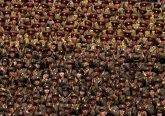 We are about to experience a substantial influx of unmanned systems into the maritime military services. On 17 December 2013, the Royal Navy launched a Boeing ScanEagle unmanned aerial system from the Royal Fleet Auxiliary Cardigan Bay, a first for the RN in an operational theatre. This places the Royal Navy alongside the British Army and Royal Air Force in demonstrated drone capability; the latter service has been operating surveillance drones in Afghanistan for years. Since 2012, ScanEagle systems have been in regular use by the Royal Canadian Navy. In May 2013, the Royal Australian Navy announced it would invest up to $3 billion on Northrop Grumman’s new MQ-4C Triton unmanned maritime patrol aircraft. Additionally, the latest Fire Scouts are coming online, Northrop Grumman’s MQ-8C, following its predecessor whose service in the U.S. Navy is now routine. A recent expansion of the Naval Research Laboratory in Washington, D.C., included the opening of a Laboratory for Autonomous Systems Research. The U.S. Navy announced it would introduce mine-hunting surface units by 2017, and it will not be too long before General Dynamics’ Unmanned Undersea Vehicle program produces workable unmanned submarines. Most dramatically, on 10 July 2013, Northrop Grumman’s X-47B fighter drone successfully landed on board the USS George H. W. Bush (CVN-77).
We are about to experience a substantial influx of unmanned systems into the maritime military services. On 17 December 2013, the Royal Navy launched a Boeing ScanEagle unmanned aerial system from the Royal Fleet Auxiliary Cardigan Bay, a first for the RN in an operational theatre. This places the Royal Navy alongside the British Army and Royal Air Force in demonstrated drone capability; the latter service has been operating surveillance drones in Afghanistan for years. Since 2012, ScanEagle systems have been in regular use by the Royal Canadian Navy. In May 2013, the Royal Australian Navy announced it would invest up to $3 billion on Northrop Grumman’s new MQ-4C Triton unmanned maritime patrol aircraft. Additionally, the latest Fire Scouts are coming online, Northrop Grumman’s MQ-8C, following its predecessor whose service in the U.S. Navy is now routine. A recent expansion of the Naval Research Laboratory in Washington, D.C., included the opening of a Laboratory for Autonomous Systems Research. The U.S. Navy announced it would introduce mine-hunting surface units by 2017, and it will not be too long before General Dynamics’ Unmanned Undersea Vehicle program produces workable unmanned submarines. Most dramatically, on 10 July 2013, Northrop Grumman’s X-47B fighter drone successfully landed on board the USS George H. W. Bush (CVN-77).
Technological revolutions in warfare, whether bow and arrow, gunpowder, or unmanned systems, inevitably bring about a period of tumult and reshuffling. If we are lucky, such upheaval also brings systematic self-reflection. What changes might this newest revolution in maritime technology bring about?
The Real World
Because they are maritime systems, they will be forward-deployed in peacetime to a greater degree than other technologies. Because they are unmanned—their use risking no personnel—they will inevitably be used in a wider variety of contexts than current manned maritime systems. Both forward deployment and broader application place unmanned maritime systems (UMS) alongside past great technological breakthroughs. As we stand at the forefront of this revolutionary period, it is extremely important that we envision what the changes will entail and how we as military leaders should respond.
Yet attempts to forecast these consequences are invariably made from a point of view that unwittingly accepts two questionable assumptions. First, a conceptual framework that understands military force as a tool of statecraft is taken for granted. Given various policy options, this line of thought asserts, military force stands alongside many competing actions as but one policy option among many, whether economic sanctions, political incentives, alliance building, political pressure, or shame in the court of public opinion.
This article was originally published by the United States Naval Institute, continue reading here.







No Comment